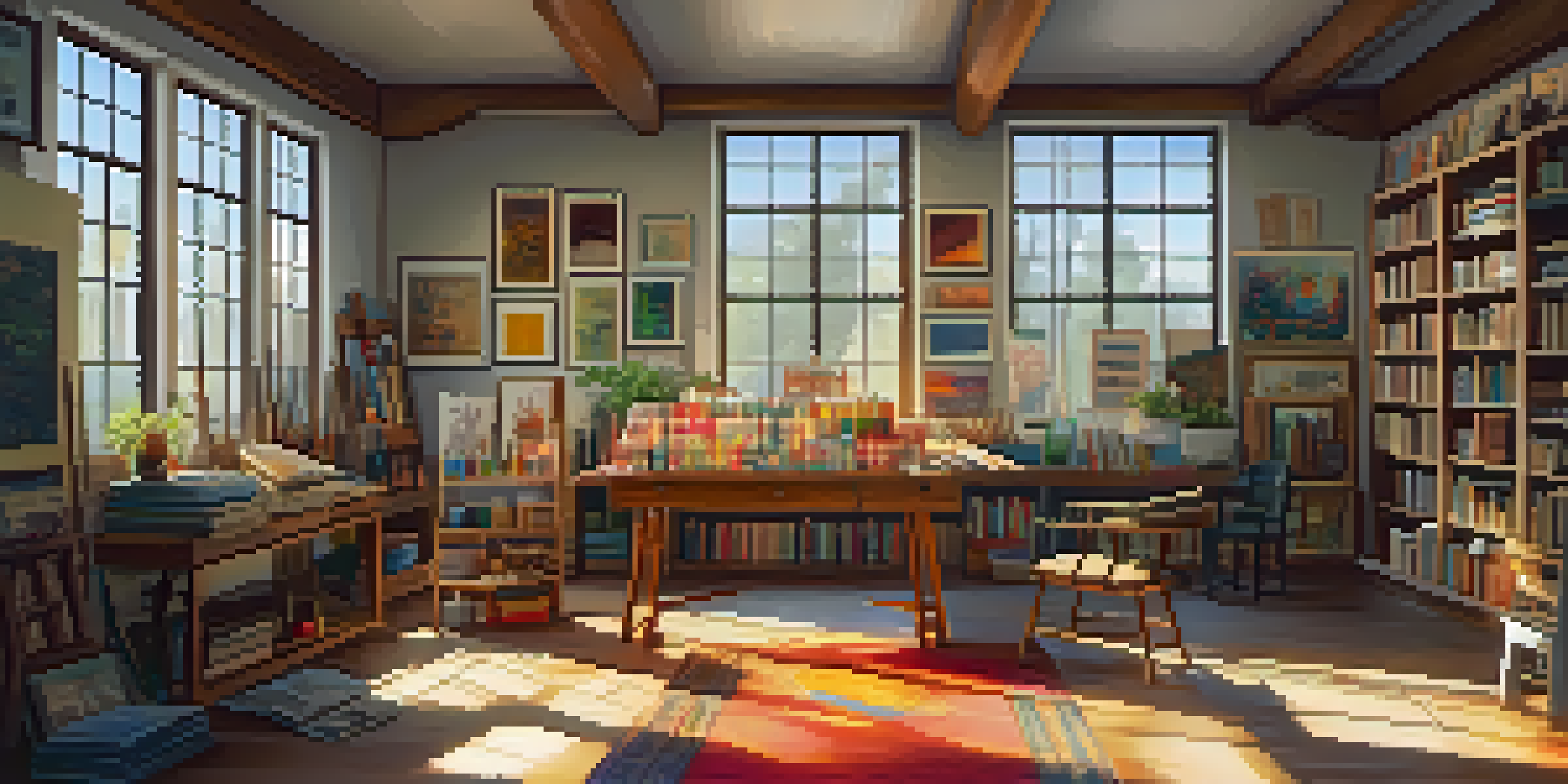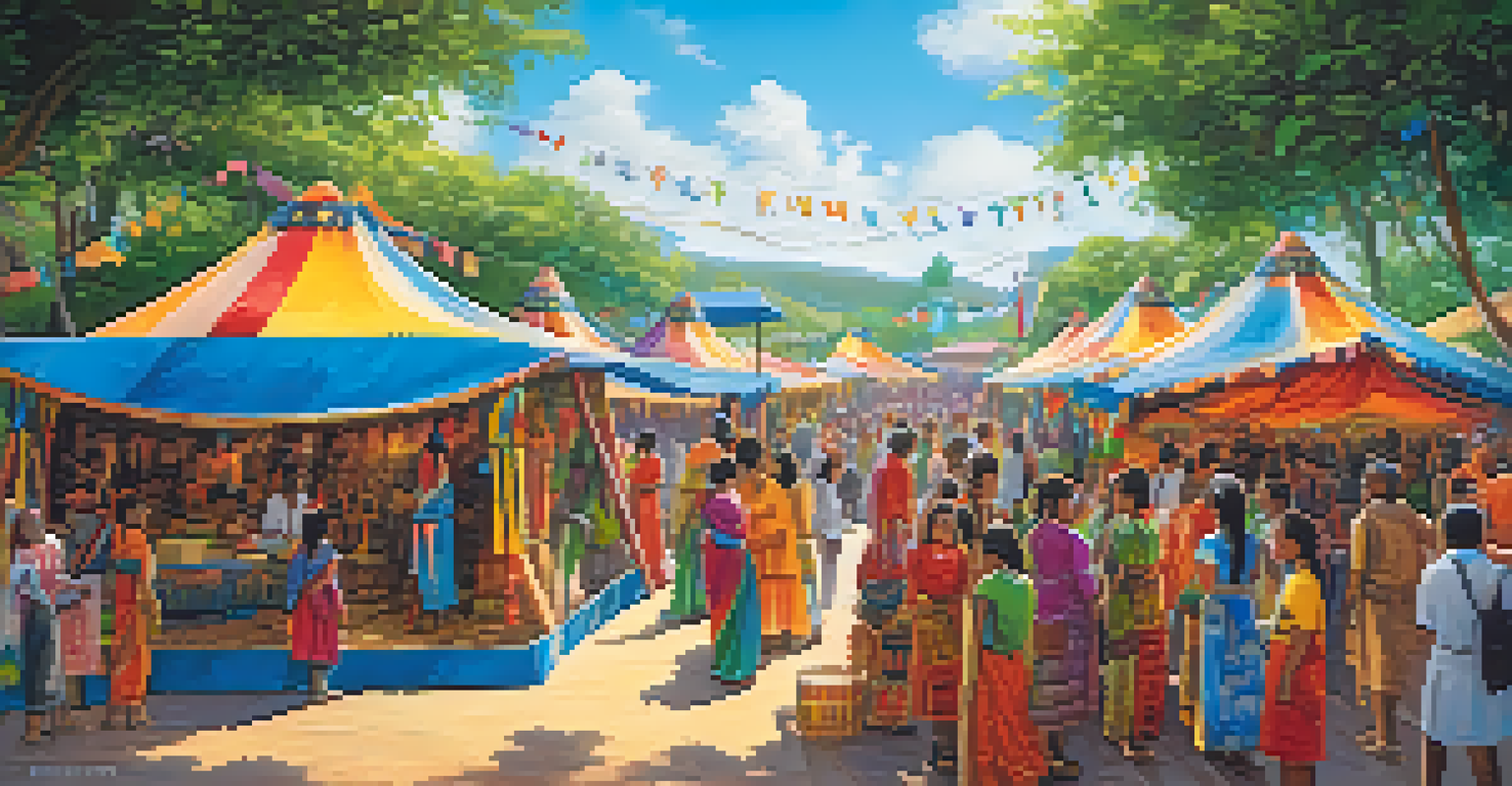Public Reactions to Cultural Appropriation in Art Exhibits

Defining Cultural Appropriation in Art Context
Cultural appropriation refers to the adoption of elements from one culture by another, often without permission or understanding. In the art world, this can manifest as artists borrowing styles, symbols, or practices from marginalized cultures. While inspiration is a natural part of artistic expression, the line between appreciation and appropriation can be blurry and contentious.
Art is a reflection of the culture it comes from, and it is our duty as artists to ensure that reflection is accurate and respectful.
For example, when a non-Indigenous artist uses Native American motifs in their work, it can lead to accusations of cultural appropriation. Critics argue that such actions can trivialize and commercialize sacred traditions, reducing them to mere aesthetics. This tension sparks debates about authenticity, representation, and respect within the artistic community.
Moreover, the conversations surrounding cultural appropriation challenge artists to be mindful of their sources of inspiration. It encourages a deeper engagement with the cultures they draw from, fostering dialogue rather than division. Understanding these nuances is essential for creating art that honors rather than exploits cultural heritage.
Public Outcry and Social Media Impact
In today's digital age, public reactions to cultural appropriation can spread rapidly, especially through social media platforms. A single tweet or post can ignite a firestorm of criticism, reaching a global audience and prompting immediate discussions. This level of exposure can amplify voices that might otherwise go unheard, leading to a more informed public discourse.

For instance, art exhibits that feature culturally appropriative work often receive backlash online, with hashtags trending in real-time. This reaction can pressure galleries and institutions to reconsider their presentations and partnerships. When the public speaks out, it forces curators and artists to confront their choices and the implications of their work.
Understanding Cultural Appropriation
Cultural appropriation in art involves borrowing elements from marginalized cultures without permission, often leading to debates about respect and authenticity.
Additionally, the immediacy of social media can foster a sense of community among those advocating for cultural sensitivity. It connects individuals who share similar concerns, allowing them to organize, share resources, and push for change. This collective power can lead to tangible outcomes, such as the cancellation of exhibits or the reevaluation of artistic practices.
Case Studies of Controversial Art Exhibits
Examining specific case studies can provide valuable insights into public reactions to cultural appropriation in art. One notable example is the controversy surrounding the 'Spirit of the Mask' exhibit, which showcased Indigenous-inspired artwork created by non-Indigenous artists. Many felt that the exhibit misrepresented and commodified Indigenous culture, leading to protests and a call for its closure.
Cultural appropriation is the theft of culture, while cultural appreciation is the celebration of culture.
Another case involved a fashion brand that faced backlash for using traditional African textiles without crediting their origins. While the brand intended to celebrate the beauty of these fabrics, it sparked a larger conversation about who gets to profit from cultural heritage. Such incidents highlight the importance of context and the potential harm of disregarding the voices of the cultures being represented.
These case studies not only illustrate the complexity of cultural appropriation but also emphasize the need for ongoing dialogue. They remind artists and institutions of the responsibility they have to engage respectfully with diverse cultures. Understanding the public's reaction can help shape future exhibits that foster inclusivity rather than division.
The Role of Artists in Cultural Representation
Artists play a crucial role in shaping cultural narratives and representation within their work. As creators, they have the power to either uplift marginalized voices or perpetuate stereotypes through their artistic choices. This responsibility calls for a thoughtful approach to how cultural elements are integrated into their art.
For many artists, the solution lies in collaboration—working directly with individuals from the cultures they wish to represent. This practice not only enriches their work but also ensures that it is rooted in authenticity and respect. Collaborative projects can lead to innovative expressions that celebrate diversity while honoring cultural traditions.
Social Media's Role in Art Discourse
Social media amplifies public reactions to cultural appropriation, fostering community engagement and prompting institutions to reconsider their practices.
Furthermore, artists can use their platforms to educate their audiences about cultural contexts and histories. By sharing their creative processes and the stories behind their work, they can foster empathy and understanding. This engagement can help mitigate the risk of appropriation and instead promote appreciation and cultural exchange.
Art Institutions and Their Responsibilities
Art institutions hold significant power in how culture is showcased and perceived. As curators and gatekeepers, they have the responsibility to create spaces that are inclusive and respectful of the cultures they represent. This includes careful consideration of the artworks they choose to display and the narratives they promote.
Many institutions are now implementing policies and practices aimed at reducing instances of cultural appropriation. This can include consulting with community representatives, diversifying their curatorial teams, and offering educational programming that highlights the complexities of cultural exchange. By doing so, they can foster a more equitable art landscape.
Additionally, institutions can serve as platforms for dialogue, hosting discussions and panels that address cultural appropriation and representation. These initiatives not only engage their audiences but also create opportunities for learning and growth within the community. By taking active steps, art institutions can help to reshape public perceptions and contribute to a more respectful appreciation of diverse cultures.
Navigating the Fine Line Between Inspiration and Appropriation
Navigating the fine line between cultural inspiration and appropriation requires a nuanced understanding of both art and ethics. Artists must reflect on their intentions and the historical contexts of the cultures they draw from. This self-awareness can help prevent unintentional harm while fostering genuine cultural appreciation.
Engaging with these issues involves asking critical questions: Who benefits from this artwork? Are voices from the culture being represented included in the conversation? Such inquiries can guide artists toward more ethical practices and encourage them to seek out authentic connections with the cultures they admire.
Artists' Responsibility in Representation
Artists must engage thoughtfully with cultural elements, promoting authenticity through collaboration and education to honor diverse heritages.
Ultimately, this journey is about fostering respect and understanding. By cultivating a mindset that values cultural heritage and seeks to honor it, artists can contribute to a richer, more diverse art world. It's a continuous process of learning and growth, benefiting both creators and audiences alike.
Future Directions and the Evolution of Cultural Discourse
As society continues to evolve, so too will the discourse surrounding cultural appropriation in art. Emerging artists and curators are increasingly aware of the implications of their work, leading to a shift toward more ethical practices. This change reflects a growing commitment to inclusivity and respect for cultural diversity within the art community.
Moreover, educational institutions are beginning to incorporate discussions on cultural appropriation into their curriculums. By equipping future artists and curators with the tools to navigate these complex issues, they can foster a new generation that prioritizes sensitivity and understanding in their creative practices. This proactive approach can help prevent future controversies.

Looking ahead, the evolution of cultural discourse will likely continue to challenge artists and institutions to reflect on their roles in shaping narratives. By embracing this challenge, the art world can create a more inclusive environment that not only celebrates diversity but also honors the rich tapestry of cultural heritage that informs artistic expression.